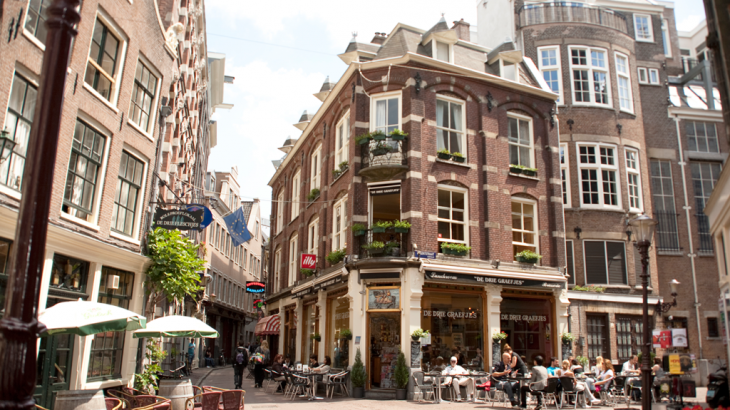Real Estate Amsterdam City Centre

A brief history
The historical centre with its beautiful concentric canals was largely built during the Dutch Golden Age in the 17th century. Despite being besieged by tourists in the summer, the central area of Amsterdam with its authentic 17th and 18th century architecture is a highly prized location.
While prices to buy or rent in comparable areas in London or Paris are still several times higher than in Amsterdam, the Grachtengordel (central canal ring) remains one of the most expensive and highly sought-after areas in the Netherlands. Many of the old canal houses have been renovated and broken down into smaller apartments, ensuring a good range of available housing. It sometimes can be difficult to find an entire house to rent or buy, but the breath-taking architecture and lovely hidden gardens make it well worth to spare no effort.
The canals that flow through these areas are littered with 750 houseboats. The Brouwersgracht and the Northern parts of the grachten (canals) are particularly highly populated, while other stretches, such as the Golden Bend, are kept empty by the City Council. Living on a houseboat looks romantic, but defrosting the ice in your toilet is no fun. A boat with 21st Century facilities is nearly impossible to find.
In the Amsterdam centre you can will find a mix of almost every kind of person; from students and artists, to Dutch yuppies, old families and business people with a huge dash of expatriates from around the globe.
The Singel
The Singel is a canal in Amsterdam which encircled the city in the Middle Ages. It served as a moat around the city until 1585, when Amsterdam expanded beyond the Singel. The canal runs from the IJ bay, near Central Station, to the Muntplein square, where it meets the Amstel river. It is now the innermost canal in Amsterdams semicircular ring of canals, lined by many beautiful, richly decorated canal houses built during the Dutch Golden Age.
When participating in a boat tour you will be able to see the narrowest house in the world — only one meter wide, De Dolphijn, a monumental canal house built in ca. 1600, once inhabited by Frans Banning Cocq, the central figure in Rembrandts painting The Night Watch, the Oude Lutherse Kerk (Old Lutheran Church), built in 1632-1633 and the Ronde Lutherse Kerk (Round Lutheran Church, also known as Koepelkerk or Nieuwe Lutherse Kerk (New Lutheran Church), built in 1668-1671.
Furthermore you will find the library of the University of Amsterdam and Amsterdams most famous flower market located between Koningsplein and Muntplein with flower boats floating in the canal.
The Haringpakkerstoren tower was part of Amsterdams Medieval city defenses. The tower stood at the beginning of the Singel, near the IJ. It was demolished in 1829. The Torensluis, built in 1648, is an arched and exceptionally wide bridge across the Singel. Now covered by cosy café terraces and a bust of Dutch writer Multatuli, the Torensluis is the oldest and widest (42 meters) remaining bridge in Amsterdam. The Jan Roodepoortstoren tower stood on one end of the bridge but was torn down in 1829. However, the towers foundations remain part of the bridge. The entrance and barred windows of the towers dungeon are still visible. The bridge, also known as Brug 9, crosses the Singel near Dam square, at Oude Leliestraat.
Dam square
Just a five-minute walk down the Damrak from Central Station takes you into this square, covered with locals and tourists day and night. It was created in the 13th century when a dam was built around the river Amstel to prevent the Zuiderzee sea from swarming the city.
There are food stalls, restaurants and shops galores, including the trendy Bijenkorf, Magna Plaza, Bonneterie and the Amsterdam Diamond centre. In the summer months, mimers and other street performers come out to surprise unexpected onlookers.
The Royal Palace (Koninklijk Palace) is one of the most pulchritudinous buildings in the Dam area. Although no longer home to the Dutch Royal family, this grand 17th century Royal Palace is still used to hold official receptions. Opposite to the Royal Palace you will see hotel Krasnapolsky and on the South side of Dam Square stands the controversially phallic National Memorial statue, erected in memory of Dutch soldiers and members of the resistance who died in World War 2. Unveiled in 1956, the monument stores soil from all of Hollands provinces as well as from the Dutch East Indies and if you go to the back of the obelisk tower, you will find the provinces crests.
Other must-sees in Dam Square are Madame Tussauds, the world famous wax works museum.
Please contact us
Please fill in the form below and we will contact you as soon as possible. If you want to reach out to us; please call +31 20 33 000 31 (Monday to Friday 9am-6pm)